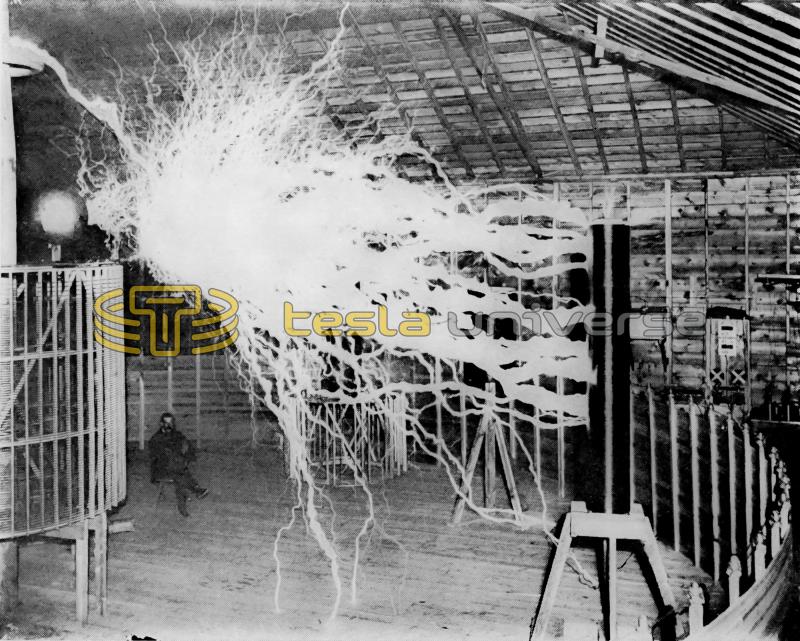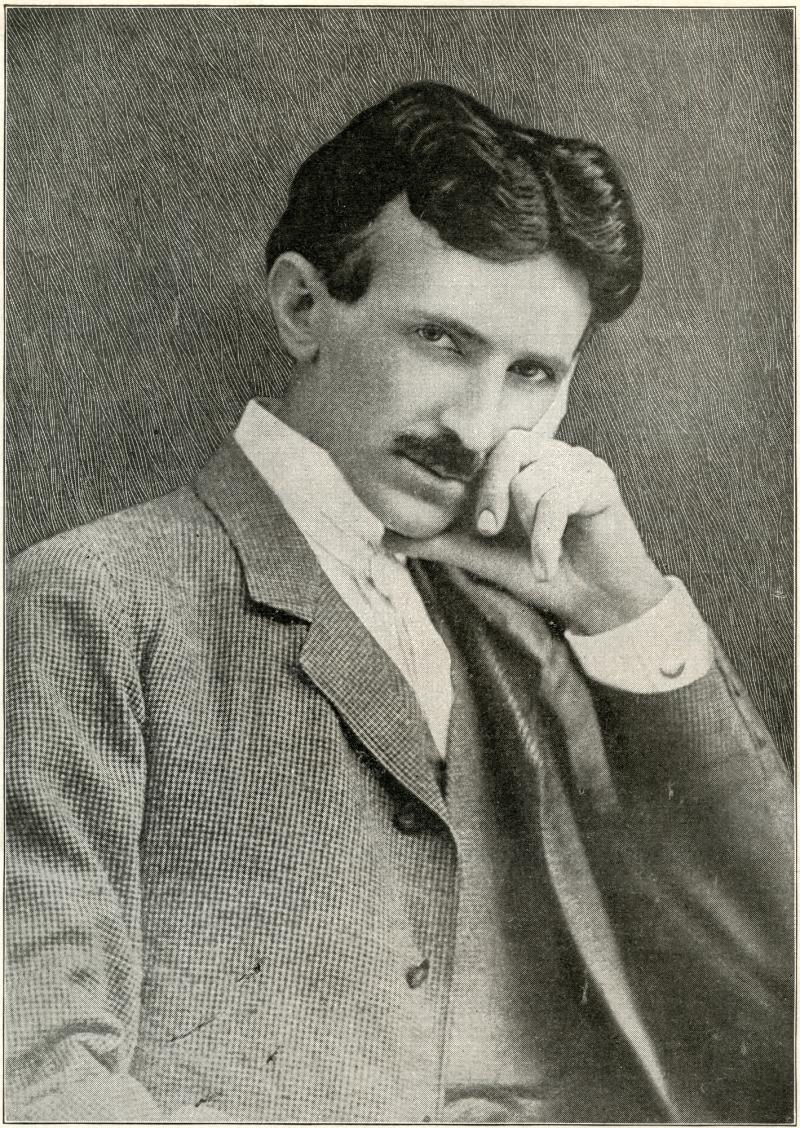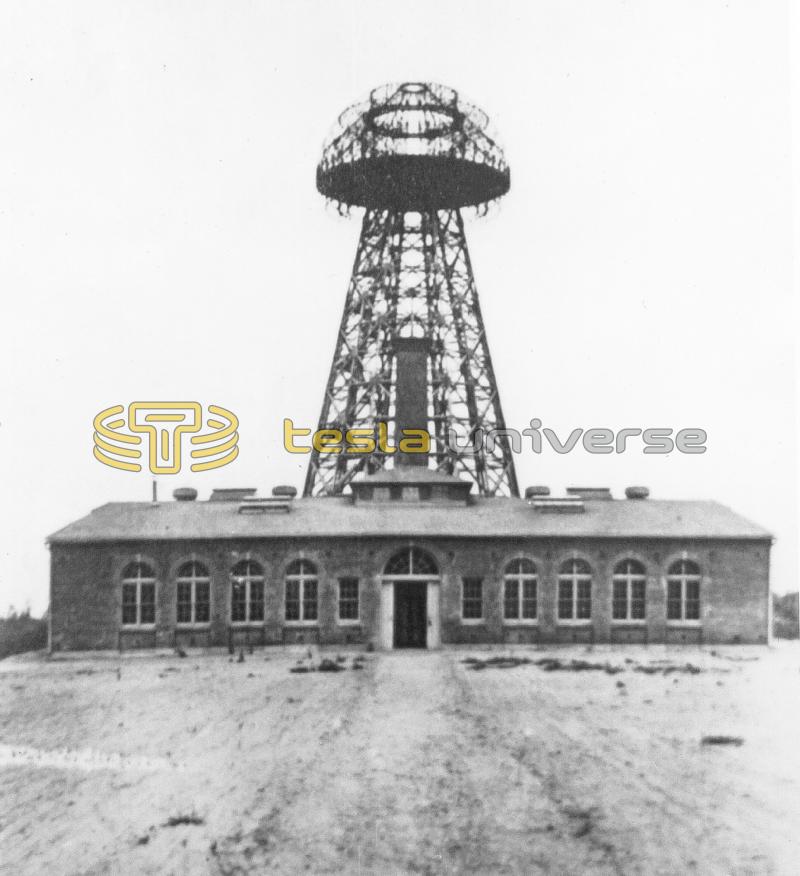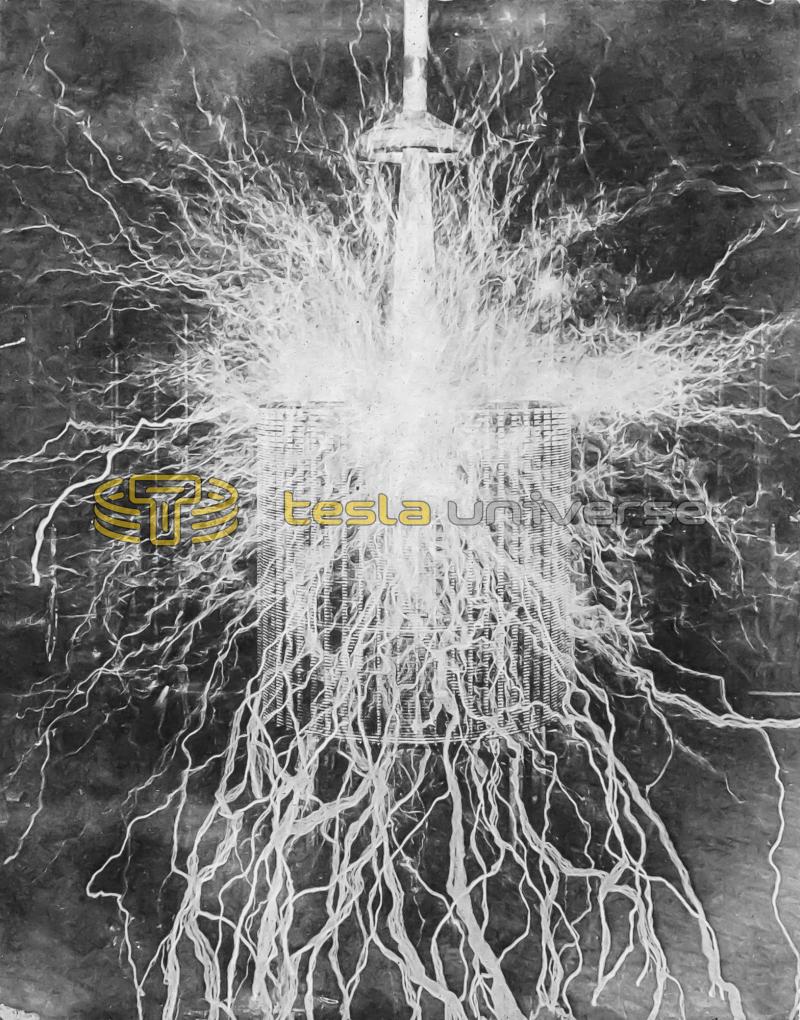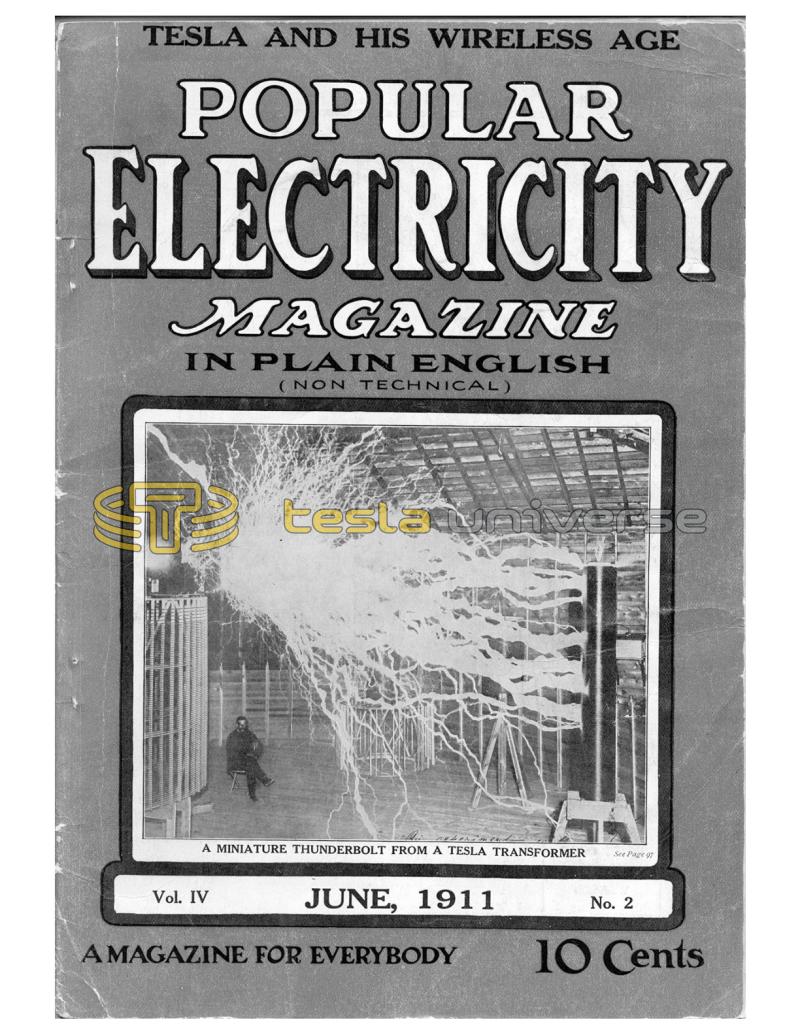
Nikola Tesla Articles
Tesla and His Wireless Age
“I have produced electrical oscillations which were of such intensity that when circulating through my arms and chest they have melted wires which have joined my hands, and still I have felt no inconvenience. I have energized with such oscillations a loop of heavy copper wire so powerfully that masses of metal placed within the loop were heated to a high temperature and melted, often with the violence of an explosion. And yet into this space in which this terribly destructive turmoil was going on I have repeatedly thrust my head without feeling anything or experiencing injurious after effects.”
The speaker was a tall, spare man with a clean-cut, thin, refined face and eyes of exceptional keenness. He was sitting at a broad flat-top desk in his office on the twentieth floor of the Metropolitan Tower, and his eyes wandered restlessly in just pride from a photograph of his old friend Lord Kelvin on one wall to a large photograph of electrical streamers rivalling the lightning on the other. The speaker was Nikola Tesla.
But before describing his wonderful theories and experiments in the wireless transmission of energy, let me say something of the man and his life. And first of all, it must not be forgotten that today over four million horsepower of water falls are harnessed by Tesla’s alternating current system. That is like saying that forty million men - untiring, working without pay, consuming no food, shelter or raiment - are constantly laboring to provide for our wants. In these days of conservation, it is interesting to note that this vast electrical energy derived from waterpower saves a hundred millions of tons of coal every year. Our trolley roads, our subways, many of our electrified railroads, the incandescent lamps in our homes and offices, all use a system of power transmission of this man’s invention.
Nikola Tesla was born at Smiljan, Lika, in the border country of Austria-Hungary in 1857. He was the son of a Greek clergyman and orator and Georgia Mandic, herself somewhat of an inventor like her father before her. The young Tesla attended the schools of Lika and Croatia, and later the Polytechnic at Gratz as well as the University of Prague, in Bohemia. At Gratz he saw and operated a Gramme machine for the first time, and was so struck with the objections to the use of commutators and brushes that he made up his mind to remedy that defect in dynamo-electric machines.
Tesla began his practical career in Buda Pesth in 1881. His first electrical invention was a telephone repeater. Later he was engaged in various branches of engineering and manufacture in Paris, and in 1884 he came to the United States. Here he found employment for a while with the Edison Company in Orange, New Jersey. After the prescribed period of residence he became a naturalized American citizen.
After numerous scientific addresses and papers and inventions like the third brush regulation he entered business for himself, the Tesla Electrical Company of New York being formed in 1887. Already he had conceived his great idea of the rotating magnetic field, which makes possible the transmission of power by alternating current, a system extensively used over long distances. His work with dynamos, transformers, induction coils, oscillators, arc and incandescent lamps, involving alternating currents of high frequency and high potential, at once brought him great fame. In fact, the immense stimulus of Tesla’s work to the study of alternating current motors would alone stamp him a leader in the field of electricity if he had contributed nothing else. It has sometimes been asserted that Professor Ferraris anticipated Tesla in the rotating magnetic field, but as a matter of fact Ferraris was purely theoretical, halting and impractical in his work. The mere fact that he published a paper describing his work subsequently to Tesla’s discoveries must rank only as one of those curious and frequent scientific coincidences. Ferraris himself stated some years ago that Tesla could not possibly have known of his (Ferraris’s) work. These notable patents were acquired by Westinghouse, and were the subject of much litigation before being finally upheld.
A mere list of Tesla’s inventions and discoveries is formidable. In 1886 he was the inventor and discoverer of a system of arc lighting, and in 1888 came the Tesla motor and system of alternating current power transmission, popularly known as the two phase and three phase multiphase, or polyphase systems. A system of electrical conversion and distribution by oscillatory discharges came in 1889, and a year later studies in the generation of high frequency currents and their effects. The transmission of energy through a single wire without return was announced in 1891, while from that year until 1893 he was engaged in investigation of high frequency effects and phenomena.
In 1893 he announced a system of wireless transmission of intelligence, and in 1894 and 1895 his work was on mechanical oscillators and generators of electrical oscillations. During the years 1896 to 1898 he was interested in research in radiation and the discovery of material streams and emanations. Finally in 1897 he first announced his “high potential magnifying transmitter” which, as he claims, makes possible a system of economical transmission of power without wires. From that date down to the present he has been constantly at work on this idea. No other human being knows anything like as much about this fascinating subject as Tesla.
Among his other inventions should be mentioned what he calls the art of telautomatics (1898-’99), a system for controlling the entire operation of, say, a boat by wireless impulses at a distance, even out of the range of vision. In 1899 and 1900 he was engaged in experiments in burning atmospheric nitrogen and the production of other electrical effects of transcending intensity, while during the next two years he was working on methods and apparatus for magnifying feeble effects. From 1902 to 1903 he studied the problem and art of individualization, and since then his work has been in world telegraphy and telephony and in the designing and building of a large power plant for the transmission of power without wires, which I shall describe presently.
But as most people associate Tesla with high frequency, high potential electrical currents, rather than with such things as his electrolytic meter, his dynamo commutators and brushes without sparks, and the thousand and one other notable contributions he has made, I cannot leave the subject without another word. Prior to Tesla’s inventions only direct current was used. Now we use alternating current. As one of the justices who decided a case in his favor some years ago well put it:
“It remained to the genius of Tesla to capture the unruly, unrestrained and hitherto opposing elements in the field of nature and art and to harness them to draw the machines of man. It was he who first showed how to transform the toy of Arago into an engine of power. The Arago rotation taught the schoolboy fifty years ago how to make a plaything, and that plaything embodied the principle which Tesla discovered - that a rotating field could be used to rotate an armature. He first conceived the idea that the very impediments of reversal indirection, the contradiction of alternation, might be transformed into power, producing rotations, a whirling field of force. What others looked upon as invincible barriers, impassable currents, and contradictory forces he seized and, by harmonizing their directions, utilized in practical motors in distant cities the power of Niagara.”
And now for Tesla’s scheme of wireless transmission of energy. A few years ago it may be remembered he stood in the theater of the Royal Institution with oscillatory currents of unheard of voltage playing about his unharmed head. This taste for the sensational has always been one of Tesla’s commanding characteristics. He prides himself on it. Others may criticise Tesla for this love of the sensational, but he himself will sit for hours talking about some of his seemingly impossible exploits, while the mention of one of the inventions which, as he says, “the world calls practical,” will fail to elicit from him so much as a wink of an eyelash. As he himself told me, it is doubtful if anyone ever performed so many really dramatic, hair-raising experiments as he. He is as proud of them as a boy. The zest with which he tells of how, after showing Sarah Bernhardt his most dare-devil exploits, she hurried away almost in a state of nervous collapse, is equalled only by the off-hand manner in which he mentions currents of 80,000,000 vibrations a second, and his descriptions of sparks and flames in his laboratory experiments which rival, if not equal, the lightning itself. I recall that, in referring to one of his experiments, somewhat like that in the opening paragraph of this article, he anticipated my inquiry by saying: “I don’t do that any more; it is too dangerous.”
But though there may be much of the pure love for the dramatic in Tesla’s announcements, there is really more of what may be called truly scientific imagination. Such experiments with all their elaborate stage setting Tesla believes to be of far greater practical importance than even those of his inventions “which the world calls practical.” For, as he tersely put it: “The economic transmission of power without wires is of all-surpassing importance to man.”
It all began, as he will tell you, in his observations - “revelations” he calls them - during a great thunderstorm on July 3, 1899. Out of it came his “high potential magnifying transmitter,” and such patents along this line of wireless transmission as Nos. 645,576 and 649,621, for transmission of electrical energy in any quantity to any distance with transmitting and receiving apparatus movable, as in ships and balloons.
“We are on a conducting body insulated in space, of definite and unchangeable dimensions and properties,” he says. “It will never be possible to transmit electrical energy economically through the body and its environment except by essentially the same means and methods which I have discovered, and the system is so perfect now that it admits of but little improvement.”
“Under certain conditions,” says Tesla, “the atmosphere which is normally a high insulator assumes conducting properties and so becomes capable of conveying any amount of electrical energy. I would undertake to transmit through my body with such currents the energy of all the dynamos at Niagara.”
To carry out his ideas he has devised a plant of which he says: “A popular error which I have often opportunity to correct is the belief that the energy of such a plant would dissipate itself in all directions. This is not so. Electricity is displaced by the transmitter in all directions equally through the earth and air, but energy is expended only at the place where it is collected and used to perform some work. A plant of 10,000 horsepower might be running full blast at Niagara, and one flying machine of 50 horsepower might be in another place. Only 50 horsepower would be furnished by the plant.
“Although the electrical oscillations would manifest themselves all over the earth at the surface as well as high in the air, virtually no power would be consumed. My experiments have shown that the entire electrical movement which keeps the whole globe a-tremble can be maintained with but a few horsepower. Apart from the transmitting and receiving apparatus the only loss incurred is the energy radiated in the form of Hertzian or electro-magnetic waves which can be reduced to an entirely insignificant quantity.”
Finally, as to the now famous Tesla Tower. This is a huge mushroom shaped tower at Wardenclyfife, Long Island, New York, a place some 60 or so miles out from the city along Long Island Sound. This tower is 185 feet high from the ground to the top of the cupola. The smallest dimension across the base of uprights is 97 feet. The height to the ledge of the cupola is 153 feet, while the cupola itself is 65 feet in diameter. The tower has eight sides, with a staircase and lift for reaching the cupola platform. It is from this cupola that wireless vibrations are to be shot out in any desired voltage to given points scattered over a very wide radius. Not only so, but Tesla dreams of making it a receiving station to which can be transmitted a ceaseless day and night service of millions upon millions of volts from such power plants as those of Niagara. Thence such a force could be transmitted to run the street cars, the elevateds, the subways, the factories, the electric lights, the railroads, the automobiles, the ferries, the trucks, the heaters in the cellars and the clocks in the parlors of the great city of New York.
Tesla’s dream also includes the erection of towers similar to this at Wardenclyffe at convenient places, everywhere, for the purpose of distributing wireless energy for all these purposes over their respective areas. Some towers would be supplied with power from such sources as Niagara Falls or Victoria Falls. Or plants will be erected alongside or between the main uprights, each distributing a huge horsepower under a tension of millions of volts. Mr. Tesla declares he can handle the most amazing voltage from such towers with absolute safety, and his dream is of an America dotted over with these towers, each supplying all the energy for, say, an area of 30 miles about and spaced from each other 60 miles in such a manner that practically every inch of ground is covered by his new wireless service.
Not only wireless power service but wireless telegraph and telephone service will be furnished by this network of towers, covering the entire earth and making it possible for a man in New York to talk directly with his friend in London. Tesla dreams of the day when a man may dictate his orders in San Francisco and they may be set up and printed directly in New York, of a day when not merely photographs will be transmitted by wireless, but when one can actually see over the wireless the friend to whom he is talking in some distant part of the earth, watch his facial movements, “see” him as plainly as if he were in the room. In fact the possibilities of the wireless age of the future as Tesla conceives it are boundless.
That is why he is more interested in schemes that are called “visionary” than in those of his inventions which “the world calls practical.”
As he himself has put it in a recent statement: “A systematic research carried on for a number of years with the object of perfecting a method of transmission of electrical energy through the natural medium has led me to recognize three important necessities: First, to develop a transmitter of great power; second, to perfect means for individualizing and isolating the energy transmitted; and third, to ascertain the laws of propagation of currents through the earth and atmosphere.”
All these things he now believes can be done. He believes that he has discovered a means of pouring electrical energy into the air, as it were, without loss except at the point where a properly tuned instrument will be able to draw it out, at the point where it is needed.
“When the great truth accidentally revealed and experimentally confirmed is fully recognized,” he says in speaking of the inventions with which he believes he will make the wireless age a fact, “it will be seen that this planet, with all its appalling immensity, is to electric currents virtually no more than a small metal ball, and that by virtue of this fact many possibilities, each baffling imagination and of incalculable consequence, are rendered absolutely sure of accomplishment.”
